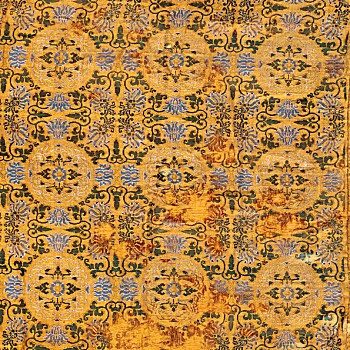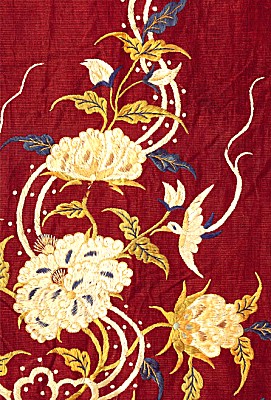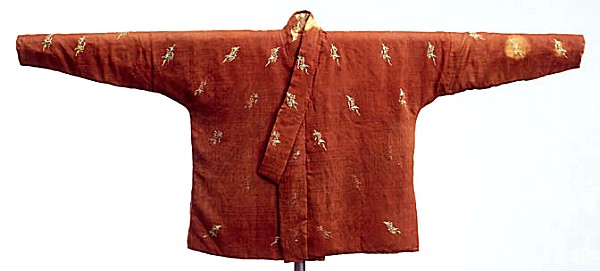| |
Unique silk garments and accessories from what is today
northern China are the focus of the new special
exhibition at the Abegg-Stiftung in Riggisberg. These
splendid textiles, around 1,000 years old, provide an
insight into the luxurious dress worn by the upper
classes of that time. Together with elegant gold-trimmed
ceramic vessels, they introduce us to the world of luxury
and beauty that the princes of the Liao Dynasty
in-habited – even in the grave.
The elite of the Liao Dynasty clad itself in silk
from head to foot, both in life and in death. This
exhibition shows textiles found in the grave of a
noblewoman, whose funeral wardrobe included cloaks,
coats, jackets, pants and skirts, as well as a headdress,
splendid ornamental bows and silk boots. It is likely
that the deceased was wrapped in several layers of
clothing. She seems to have been buried wearing three
pairs of pants and two skirts as well as at least two
jackets and a coat.
NOMADS DRESSED IN SILK
The little-known Liao Dynasty was founded by the nobility
of the Qidan, a group of semi-nomadic tribes that
regularly set up camp in the upper reaches of the Liao
river in what is today northern China. In 907, the tribes
united and founded the Qidan Empire, which was later
renamed Liao. This empire rose to become the principal
power in Eastern Asia and at one time controlled an area
stretching from Manchuria and Mongolia as far as what is
today Beijing. The Qidan also defeated the army of the
Song Dynasty that ruled the rest of China. At the peace
talks between them it was agreed that the militarily
defeated Song Dynasty pay a tribute of 200,000 bolts of
silk a year. The Qidan elite then had this silk worked
into the most exquisite raiments, consisting of several
layers of fabric. Indeed, the silk was so plentiful that
it was used even as a lining material and for padding.
RADIANT COLOURS, ELEGANT DESIGNS
The exhibition features seventeen of the Qidan's
magnificent, multi-layered silk garments and various
accessories. These textiles are around one thousand years
old and have survived thanks to the dry climate
prevailing in northern China and to years of painstaking
conservation and restoration work at the Abegg-Stiftung.
The textiles' attractive colours, highly detailed woven
patterns and elegant embroidery make them a particularly
stunning sight for today's visitor. Finely textured plain
silk gauze was often used for the visible outer layer of
a garment, and this then lavishly embroidered with silk
and gold thread. Some items, for example, are strewn with
enchanting flower-and-bird motifs on a dark red ground.
The blue skirt embroidered with large dragons is
particularly impressive, while fabrics with multicoloured
designs are embellished all over with floral medallions,
lions and dragonfish, all of them vibrant with colour.
PRECIOUS GRAVE FURNISHINGS
The magnificent culture of the Liao Dynasty has only come
to light as a result of excavations carried out over the
last twenty years. Spectacular finds in richly furnished
tombs testify not only to the significance of textile
art, but also to a high level of skill in the crafting of
other materials too. To complement the fascinating
garments, the special exhibition also includes a silver
funeral mask with matching earrings which – like the
textiles – are from the Abegg-Stiftung's own
collection as well as a selection of exquisite
Liao-period vessels on short-term loan from a private
collection. These fascinating items, some of them made of
porcelain, others of dark wood, are each embellished with
the most intricately worked gold mounts and so provide an
evocative impression of both the quality and the sheer
extravagance of Qidan craftsmanship. Even precious items
such as these were used as burial objects.
|


